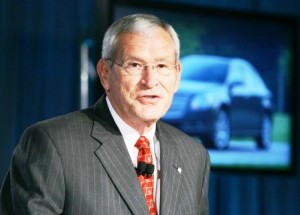General Motors Chairman Ed Whitacre announced late this afternoon that the Board of Directors had accepted the resignation of CEO Fritz Henderson, after what Whitacre said was a “hectic day.”
Whitacre takes over the job while a search for a new GM Company president and CEO is initiated.
Whitacre said it was time to accelerate progress toward returning to profitability and “repaying the American and Canadian taxpayers as soon as possible.”
(Who pushed Henderson? Click Here for TheDetroitBureau.com’s inside analysis.)
In its first quarter since emerging from bankruptcy last July, GM reported a $1.2 billion loss under Henderson’s leadership.
GM’s business results and their trend, as well as the size of the global auto markets are all key to the pricing – and crucially, the acceptance – of an impending public stock offering of GM Company, which could come as soon as next year.
It is the eventual public sale of the stock that will determine how much of a return, — if any — taxpayers will realize on their investment.
However, creating a market for the new stock when the United Auto Workers Union and the Canadian and U.S. governments all want to sell large blocks as soon as possible will be difficult task.
The U.S. Government, whose taxpayers via $60 billion in support hold a majority interest in the reorganized company, was informed this afternoon after the board’s decision, according to a GM spokesperson.
He also said it was in the “best interest of the company at this time “that Henderson depart given “where we are at this point.”
In spite of ongoing media speculation about his immanent firing, Ray Young remains, for the moment, Chief Financial Officer. Robert Lutz also remains as the head of marketing. GM’s sales year-to-date are down 32% in market that is off about 24%.
The latest move confirms the lack of confidence in the competence of GM’s inbred management that the U.S. Treasury Department’s Auto Task Force head, Steven Rattner, had observed after meeting with the previous Chairman, Rick Wagoner and his team.
Wagoner was subsequently fired as a condition of further government assistance to the bankrupt firm, which was bleeding cash at an unsustainable rate.
Henderson was the author GM’s reorganization plans under Wagoner that Treasury summarily rejected as inadequate before forcing it into bankruptcy this past June.
“Those plans evinced a state of denial as to the magnitude of their problems, the necessary changes and the conditions under which the Administration might provide further assistance,” Rattner said in a speech last month.
“At GM, we faced a bigger management challenge than even its reputation led us to expect. Take, for example, the lack of financial discipline. We saw no indication of the finance staff pushing back on the operating divisions to achieve better results, as is customary. Analyses seemed engineered to support pre-ordained conclusions. Symbolically, we never heard the words shareholder value,” Rattner said.
“The cultural deficiencies were equally stunning. At GM’s Renaissance Center headquarters, the top brass was sequestered on the uppermost floor, behind locked and guarded glass doors. Executives housed on that floor had elevator cards that allowed them to descend directly to their private garage without mixing with lower ranking colleagues.
“In that insular world, Chairman and CEO Rick Wagoner and his team appeared to believe that virtually all their problems resulted from some combination of the financial crisis, oil prices, the yen-dollar exchange rate and the UAW,” Rattner said.
It is now clear that Treasury made a calculated decision not to fire the two top officers of GM at the same time as it forced the company into bankruptcy.
The other shoe has now dropped. And Henderson was kicked by it.
Ed Whitacre promised reporters that more details would come in the days ahead and refused to take questions after reading a brief statement.
Whitacre said, “Fritz has done a remarkable job in leading the company through an unprecedented period of challenge and change. While momentum has been building over the past several months, all involved agree that changes needed to be made. To this end, I have taken over the role of Chairman and CEO while an international search for a new president and CEO begins immediately. With these new duties, I will begin working in the Renaissance Center headquarters on a daily basis. The leadership team – many who are with me today – are united and committed to the task at hand.”

